Nikon Lens Nomenclature
- a study in frustration
Confused ? If you are new to the Nikon line of
photographic equipment, you may find yourself inundated with
terminology and acronyms that leave you scratching your watch (or
winding your head) in bewilderment. Hopefully, the following can
take some of the mystery out of the process, it pertains to
Nikons built after the rangefinder era. You need to know some
definitions first.
ADR stands for Aperture Direct Readout. ADR
is the small f-stop number that appears on a small ring at the
very back of the later lenses. If you look carefully at the body
of later model manual focus Nikon cameras, you may see a small
window at the top of the lens mounting ring. Ambient, or
surrounding light, is reflected off the ADR ring through the
small window into the view finder, allowing you to see what f-stop
you have set without removing your eye from the focusing screen.
AI stands for Automatic Indexing.
AI allows you to perform metering with the lens wide open at it's
maximum aperture (so you can see to focus with the screen at it's
brightest) - then as the shutter is released, the lens "stops
down" (or the aperture becomes smaller to what you have set
on the ADR) to properly expose the picture.
Non - AI stands for the early bayonet-mount
lens series that did not offer automatic indexing. You
will often see these lenses offered for sale and described
variously as "NonAI", "NAI (erroneously - NAI
should stand for Nikon AI)", "Lenses with prong IC"
or even "Nikon prong". One clue that a lens is Non-AI
is when you see a description such as "Nikkor-Q 135/2.8"
- The "Q" (or other letters) is the early designation
that gives the number of elements in the lens.
Non - AI (The early bayonet-mount
lenses)
|
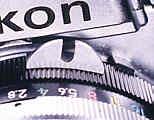
|
Solid "ears" (see note) on your lens
indicate an Non-AI lens. These lenses can not
be mounted on many of the later bodies without causing
damage because the "ears" strike the body prism
when you mount them. See the
charts to determine if they will physically mount on your
camera body. If the lens will mount on your camera body,
then check if it will allow normal metering or if you are
required to "stop down" the lens to meter. If
you are required to "stop down" to properly
meter, you first focus the lens at it's maximum aperture
with a bright screen, then "stop down" to meter
for proper exposure, then release the shutter. (Not very
handy to do) Note: In some
circles referred to as 'bat ears'. |

|
If the black outer rim on the lens base is solid all
around the lens (no meter coupling ridge) you know it
definitely is a Non-AI lens. |
AI'd (Non - AI Lenses physically
converted to AI after manufacture) and AI Lens
|
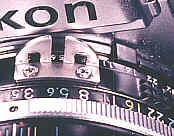
|
When Nikon developed AI, users of the old
lenses and bodies were not left out in the cold like many
of the other manufacturers did to their customers. They
offered factory alterations to Non-AI lenses so their
customer didn't have to start over collecting lenses to
mate with their "new" updated camera bodies.
These alterations are no longer offered by the factory,
but other folks do them still - see the links page for
addresses. These "ears" have holes (see note) in them (as do
later AIS lenses) and are mounted further out on the lens
to clear the prism and allow mounting. A meter coupling
ridge was added. Note :
referred to in some circles as 'hog's nose'. |

|
If the black outer rim on the lens base has a rim (meter
coupling ridge), the lens is either AI or AIS. Note the
presence of the "ears" in this picture - Series
E and AF lenses don't have ears as is the case with some
late production AIS lenses. |
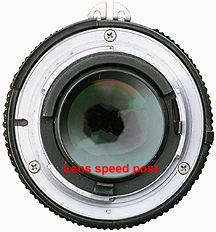 |
An original AI mount is shown at left - if
the lens has been AI'd (or modified) from an older non-AI,
it will not have the Maximum Aperture Indicator Post that
is shown at the 6:00 position in the picture. The
focusing ring configuration, colors of ADR number, etc.
are not a sure indication that the lens is an original AI.
Some late production non-AI lenses have all the outward
physical appearances of AI lenses, but when modified they
will not have the post. 
|
AIS (Automatic Index - Shutter)
Lens
|
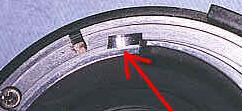
|
If there is a machined groove (Lens Type
Signal Notch) in the base of the lens, you have an AIS,
Series E, or Auto Focus (AF) lens. The purpose of the
groove was to let the camera body know that aperture stop
down was linear. |

|
Your camera can take advantage of AIS if it has this
protruding pin on the camera lens mounting ring. If the
pin is not on the camera body, it can't take advantage of
the AIS feature, but the lens will operate as AI. |
Series E Lens
|
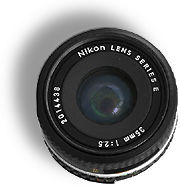 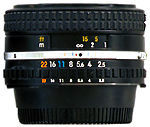
Series E 35/2.5
|
If the lens does not have "ears",
it is probably* a Series E
lens or AF lens. Series E lenses have the machined groove
in the lens base like the AIS lens, are manual focus, are
marked as Series E and have an ADR ring. Developed for
the smaller Nikon EM camera bodies as a consumer-grade
lens and often denigrated for their build, Series E
lenses include some of the best optical values in the
Nikon line. The line included three zooms and five fixed
focals; The prime lenses are: E 28mm f2.8; E 35mm f2.5; E
50mm f1.8; E 100mm f2.8; E 135mm f2.8. The Series E Zoom
lenses are: E 36-72mm f3.5, E 75-150mm f3.5 and a E 70-210mm
f4.0. The E series zooms are "one-touch"
zooms - the same ring is used for zooming and focusing. * The
word 'probably' was added after learning that some later
production AIS lenses were manufactured without 'ears'.
Morale : Never say never. |
AF - AIS Lens
|
| When Nikon started making autofocus (AF)
bodies in response to other manufacturers, it
incorporated AIS lens technology as well as an in-camera
focusing drive motor. The AF - AIS lenses have the AIS
groove machined in the lens mounting plate and a slotted drive screw inlet into the
mounting plate at about the 5:30 position - there are no
"ears" on the lens. At the 12:00 position on
the mounting plate, you will see 5
electrical contacts. You will see these lenses
normally marketed as AF AIS. Focusing speed was not much
to brag about and Nikon later improved it. |
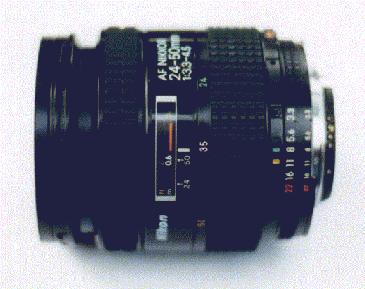
Nikon 24-50/3.3-4.5 AF AIS
|
AF "D" Lens
|
| Technology continued to improve as more
functions were added to camera bodies. One improvement
was the ability to meter in "3-D" mode, an
improvement which allows the body (through a chip in the
lens) to better assess distance from the focal plane to
the object being photographed. AF"D" lenses are
marked on the lens barrel. These lenses also have the
slotted drive screw and 5 electrical contacts in the base
plate. |
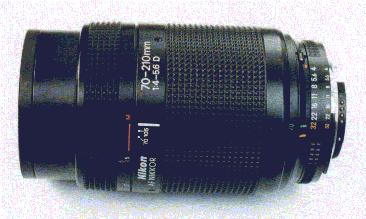
Nikon 70-210/4-5.6 AFD
|
AF "S" Lens
|
| So, you're still hunting for
the "perfect" lens eh ? How about a "silent
wave" focusing lens with an improved focusing speed
over the older AF-AIS lenses? How to get this? Put a
silent wave focusing motor in the lens itself to
make it quiet. Note that not all AF bodies can autofocus
with these lenses (see AF body
chart) because they lack the circuitry to drive the
lens focusing motor. |
IX Lens
|
| The Nikon IX lenses
are made for the Nikon APS
(Advanced Photo System)
camera bodies (Pronea 6i and Pronea S) and are included
here for informational purposes only since they can
not be mounted to Nikon 35 mm cameras even
though they may appear to be 35 mm lenses. The rear
elements of these lenses extend back into the body and
can not be mounted even if the 35 mm body provides true
mirror lock up (MLU). The Pronea 6i and Pronea S bodies
can accept and use 35 mm AF lenses, so the
interoperability of this lens series is a one-way street.
|
And after all this, you're still not satisfied? There is talk
(on today's discussion groups among the dreamers anyway) about
matching the Canon "IS" (Image Stabilization) lenses -
where the lens helps out with "camera shake" so your
pictures don't get blurred when you try to hand-hold the camera
at a shutter speed that's really too slow for the lens' focal
length. Nikon hasn't got there as of this writing, but who knows?
My advice is to get a tripod until then.
Along the way, there are several other Nikon lens
nomenclatures that we missed - they don't affect mounting to the
body, but they affect the picture and your ability to control it:
Micro - What the rest of the world refers to
as macro, a lens capable of focusing at a closer range than
normal.
PC - Perspective Control - Tilting the lens
in relation to the film focal plane - special effects.
CRC - Close Range Correction - Lens adapted
to reduce distortion when focused at macro lengths.
DC - Defocus Control - the ability to control
what zones are in or out of focus, handy for portraiture for one
instance.
NOCT - Nocturnal - "fast" lenses (wide
aperture) with aspherical elements capable of photographs in very
low light.
ED - Extra low Dispersion - Special glass
that doesn't disperse the light as it enters the lens.
IF - Internal Focus - lenses that don't
"grow" or shrink in length as they are focused.
UV - Special lenses designed to pass ultra-violet
light.
Just think - if we wanted a really fast, constant aperture,
stabilized, genuine all-purpose zoom lens with an internal
focusing silent wave motor that offered perspective and defocus
control and the ability to take really close-up pictures without
distortion, we would have the following ( and it would only cost
maybe $150,000.00, weigh 50+ pounds and take filters roughly the
size of a really large dinner platter )
Nikon 6-800/1.2D ZOOM MICRO (1:1)
NOCT PC/DC/UV/CRC AF"S" ED IS (w/Tripod Collar)
I'll put you on the waiting list
- Title, Tax and Tags not included.
(Now THAT'S a LENS Mate !) - Now,
for that new body.................
Return to Why Buy Nikon
*** Home




